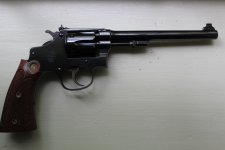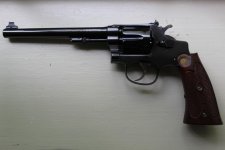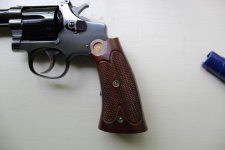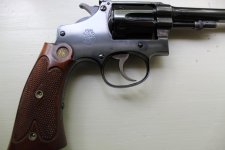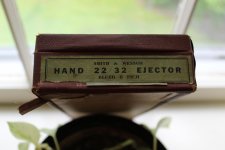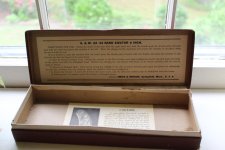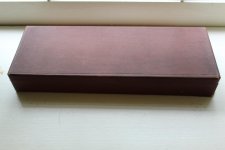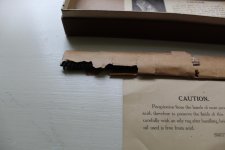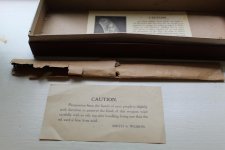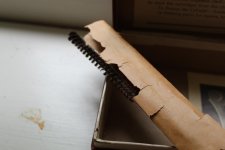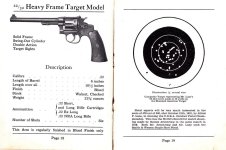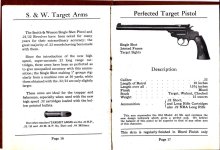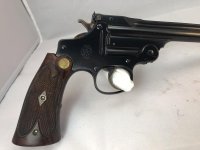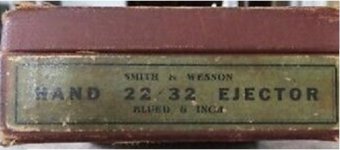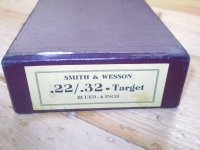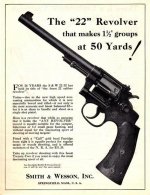Some backstory, recently a old collector passed away, and some "rumored" 100 fine guns came on the market. His research and notes haven't been found and/or released just yet. The above is pass-thru info to me, but I'm still on the trail for provenance.
Supposedly he collected, but was not a shooter or hunter.
What I did get from the collection is a very nice (very possibly unfired) 22/32 Heavy Frame Target, or Hand Ejector, possibly a Bekeart. If it does turn out to be a Bekeart it would be in the 4th category, meaning only if the Letter shows shipment to Bekeart in San Francisco.
The serial number is 224963 and matches in all know spots as well as penciled (faint but still legible) on the fragile maroon clamshell style box. Docs are old and show age. There is a brass cleaning brush w/rod inside of a very fragile "rice paper" wrapper that is also showing age. The cleaning rod shows no evidence of ever having come out of the paper, much less ever been down a bore.
This is a 6" round, pinned barrel, thin blade, bead topped on raised ramp front site, fully adjustable (W&E) rear sight, 6 shot fluted cylinder, flat faced hammer, floating firing pin, 5 screw I Frame, 2 screw concave checkered extension target grips w/ gold plated, brass medallions.
Some points that I would appreciate expert commentary (concurrence or alternative opinions) on:
1. S&W logo on right side of frame (meaning 1914 or later)
2. The 2 screw grips were gone by 1919, and this style is seen below s/n 258000, so I believe this to be an original gun dating somewhere between 1914 to 1919.
3. The box end label states Hand Ejector, yet I see modern collectors and SCSW 4th, as well as Roy's book call this model Heavy Frame Target. Do both terms apply to my gun (i.e. collector preference as to which is used to describe)?
4. Are these grips known as Roper Bekeart style, Roper or not Roper at all?
5. Does the box style, contents, or end label confirm or deny the date range?
This gun is just unbelievable to hold and point. At 23 ounces you don't even feel your holding a handgun, more like a kids toy cap gun. The sights line immediately up on target and stay there even with my old age arm fully extended off-hand position!
I bought it seemingly unfired, and it will probably remain so at least till I can track down some more provenance, and get it Lettered from SWHF.
I'm posting the 5 pics (I've GOT to get a decent camera) and then I'll post some more of the box and stuff next.
Please let me know what you think of this latest treasure addition.
Supposedly he collected, but was not a shooter or hunter.
What I did get from the collection is a very nice (very possibly unfired) 22/32 Heavy Frame Target, or Hand Ejector, possibly a Bekeart. If it does turn out to be a Bekeart it would be in the 4th category, meaning only if the Letter shows shipment to Bekeart in San Francisco.
The serial number is 224963 and matches in all know spots as well as penciled (faint but still legible) on the fragile maroon clamshell style box. Docs are old and show age. There is a brass cleaning brush w/rod inside of a very fragile "rice paper" wrapper that is also showing age. The cleaning rod shows no evidence of ever having come out of the paper, much less ever been down a bore.
This is a 6" round, pinned barrel, thin blade, bead topped on raised ramp front site, fully adjustable (W&E) rear sight, 6 shot fluted cylinder, flat faced hammer, floating firing pin, 5 screw I Frame, 2 screw concave checkered extension target grips w/ gold plated, brass medallions.
Some points that I would appreciate expert commentary (concurrence or alternative opinions) on:
1. S&W logo on right side of frame (meaning 1914 or later)
2. The 2 screw grips were gone by 1919, and this style is seen below s/n 258000, so I believe this to be an original gun dating somewhere between 1914 to 1919.
3. The box end label states Hand Ejector, yet I see modern collectors and SCSW 4th, as well as Roy's book call this model Heavy Frame Target. Do both terms apply to my gun (i.e. collector preference as to which is used to describe)?
4. Are these grips known as Roper Bekeart style, Roper or not Roper at all?
5. Does the box style, contents, or end label confirm or deny the date range?
This gun is just unbelievable to hold and point. At 23 ounces you don't even feel your holding a handgun, more like a kids toy cap gun. The sights line immediately up on target and stay there even with my old age arm fully extended off-hand position!
I bought it seemingly unfired, and it will probably remain so at least till I can track down some more provenance, and get it Lettered from SWHF.
I'm posting the 5 pics (I've GOT to get a decent camera) and then I'll post some more of the box and stuff next.
Please let me know what you think of this latest treasure addition.

